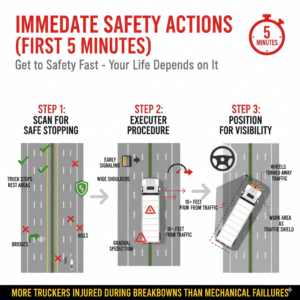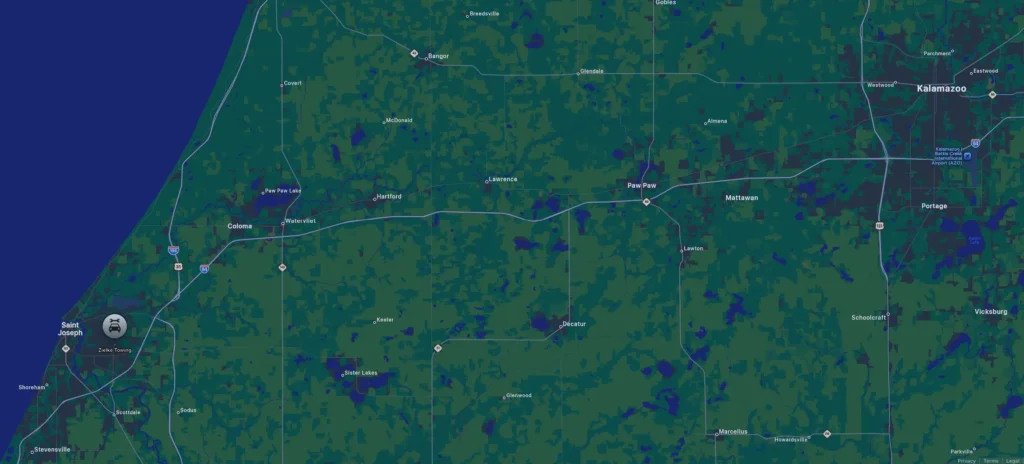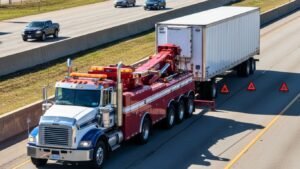Every Trucker’s Nightmare Scenario
You’re cruising down I-94 near Benton Harbor when your rig starts making that grinding sound no driver wants to hear. The engine temperature gauge creeps into the red zone, or maybe you feel that telltale vibration that signals tire trouble ahead. Your heart rate spikes as you realize you’re facing every commercial driver’s worst fear: a breakdown on a busy highway with valuable cargo and tight delivery deadlines.
Whether you’re hauling fresh produce that can’t afford delays or managing a multi-stop route with precision timing, a commercial truck breakdown can feel like a career-threatening disaster. But here’s the truth experienced drivers know: how you handle the first few minutes of a breakdown determines everything that follows.
This comprehensive action plan gives you the step-by-step emergency procedures that veteran drivers and fleet managers rely on. You’ll learn exactly what to do in those critical first moments, how to assess different breakdown scenarios, and most importantly, how to keep yourself safe while minimizing business impact.
Immediate Safety Actions (First 5 Minutes)
Get to Safety Fast
The moment you suspect a breakdown, your priority shifts to one thing: getting off the roadway alive. Industry best practices emphasize that more truckers are injured during breakdowns than during the actual mechanical failure.

Step 1: Scan for safe stopping areas immediately
- Look for truck stops, rest areas, or wide shoulders
- Avoid stopping on bridges, curves, or hills whenever possible
- If on interstate, aim for emergency stopping areas or exit ramps
Step 2: Execute proper pullover procedure
- Activate hazard lights before reducing speed
- Signal early and reduce speed gradually
- Pull as far right as safely possible, ideally 10+ feet from traffic
Step 3: Position for maximum visibility
- Turn wheels away from traffic
- Keep hazard lights activated
- If possible, position truck to shield your work area from traffic
Secure Your Vehicle and Load
Once stopped, securing your vehicle prevents secondary accidents and protects your cargo investment.
Parking brake and wheel chock procedures:
- Engage parking brake fully before exiting cab
- Place wheel chocks on both sides of rear tandems
- If available, use additional chocks for trailers on inclines
Quick cargo inspection steps:
- Check for load shifting through side doors or rear access
- Document any visible damage with photos immediately
- Secure loose straps or chains that may have come undone
- Note temperature-controlled cargo status if applicable
Alert Traffic and Authorities
Proper notification protects you legally and gets help moving quickly.
Emergency triangle placement:
- Place first triangle 10 feet behind your truck
- Second triangle goes 100 feet back on highways
- Third triangle at 200 feet for maximum warning distance
- On curves or hills, increase distances by 100-500 feet
Communication protocol checklist:
- Call dispatch first with location and breakdown type
- Contact DOT if blocking traffic or hazardous materials involved
- Call 911 if injuries, hazmat spills, or immediate danger to traffic
- Notify your insurance carrier within required timeframe
Breakdown Assessment and Documentation

Experienced drivers recommend following a systematic approach to identify the problem quickly and accurately.
Visual inspection priorities:
- Check engine compartment for obvious leaks, smoke, or damage
- Inspect all visible tires for damage, separation, or low pressure
- Look under vehicle for fluid leaks (oil, coolant, brake fluid)
- Examine exhaust system for damage or unusual emissions
Dashboard warning interpretation:
- Red warning lights require immediate shutdown
- Yellow caution lights allow continued operation with monitoring
- Check engine lights need diagnostic scan before continuing
- Air pressure warnings below 60 PSI require immediate stop
Sound and smell identification:
- Grinding noises typically indicate brake or bearing problems
- High-pitched squealing suggests belt or bearing issues
- Burning smells require immediate engine shutdown
- Sweet coolant smell indicates cooling system problems
Photo Documentation Process
Proper documentation protects you from liability claims and speeds insurance processing.
Essential photos to capture:
- Wide shot showing vehicle position and traffic flow
- Close-ups of any visible damage or mechanical issues
- Mile markers, exit numbers, and location signage
- License plates and DOT numbers clearly visible
- Time-stamped images of cargo condition
Fleet managers report that thorough photo documentation reduces claim disputes by over 80% and accelerates repair authorization.
Communication with Dispatch
Your dispatch communication determines how quickly help arrives and whether delivery commitments can be salvaged.
Critical information to report immediately:
- Exact location (mile marker, exit, GPS coordinates)
- Nature of breakdown and severity assessment
- Safety status (are you in danger?)
- Estimated repair time if obvious fix available
- Cargo status and temperature requirements
Follow-up communication requirements:
- ETA impact for current and subsequent deliveries
- Alternative routing possibilities for other drivers
- Insurance claim number and adjuster contact information
Common Breakdown Scenarios and Solutions
Engine Problems
Engine failures account for 35% of all commercial truck breakdowns, making quick diagnosis essential.
Overheating emergency procedures:
- Shut down engine immediately when temperature exceeds normal range
- Never remove radiator cap while engine is hot
- Check coolant level only after engine cools (minimum 30 minutes)
- Look for obvious leaks before calling for service
Oil pressure loss protocols:
- Stop immediately when oil pressure drops below minimum
- Check oil level with engine off and truck level
- Look for major oil leaks under vehicle
- Do not attempt to restart without confirmed oil level
Electrical system failure responses:
- Check battery connections and alternator belt first
- Test voltage at battery terminals if multimeter available
- Identify if problem affects engine operation or accessories only
- Document all dashboard warning lights activated
Tire and Brake Issues
Tire and brake problems create immediate safety hazards requiring decisive action.
Blowout safety procedures:
- Maintain firm grip on steering wheel, avoid sudden corrections
- Gradually reduce speed without hard braking
- Pull over gradually when safe to do so
- Replace with spare if available and safe to access
Brake failure emergency actions:
- Pump brake pedal to build air pressure if air brakes
- Use engine brake and transmission downshifting
- Find safe uphill area or truck escape ramp
- Use parking brake gradually as last resort
Air system pressure responses:
- Stop immediately if pressure drops below 60 PSI
- Check for major air leaks around connections
- Allow system to build pressure before attempting restart
- Call for service if leaks prevent pressure buildup
Transmission and Drivetrain Problems
Drivetrain failures often allow limited continued operation if handled correctly.
Clutch failure workarounds:
- Float gears without clutch if transmission allows
- Start in gear for limited distance travel to safe location
- Avoid stopping on inclines where restart is impossible
Differential and axle responses:
- Discontinue operation immediately if grinding or binding occurs
- Check differential fluid levels if accessible
- Document unusual noises or vibrations for service technician
Working with Roadside Assistance and Towing
Choosing the Right Service Provider
Not all roadside assistance can handle commercial vehicles properly. Industry best practices recommend pre-qualifying service providers.
Heavy-duty service requirements:
- Minimum 20-ton towing capacity for loaded trucks
- Commercial vehicle experience and proper equipment
- 24/7 availability with guaranteed response times
- Insurance coverage adequate for your cargo value
Service provider verification steps:
- Confirm they can handle your specific vehicle configuration
- Verify insurance coverage meets your company requirements
- Get estimated arrival time and service cost upfront
- Ask about on-site repair capabilities vs. towing only
Companies operating near major routes like those serving 1303 M-139, Benton Harbor, MI 49022, should maintain relationships with qualified heavy-duty service providers throughout their operating territory.
Preparing for Service Arrival
Proper preparation speeds repairs and reduces costs significantly.
Documentation gathering:
- Vehicle registration and insurance information
- Maintenance records if available digitally
- Previous service history for recurring problems
- Company authorization for repair expenditures
Safe positioning for service access:
- Ensure service truck can position safely behind your vehicle
- Clear work area of unnecessary equipment or debris
- Maintain safe distance from traffic during repairs
- Keep emergency triangles in place throughout service
Repair vs. Tow Decision Making
Making the right decision about field repairs versus shop service affects both costs and safety.
On-site repair considerations:
- Simple fixes like belt replacement or fluid top-offs
- Minor electrical problems with obvious solutions
- Tire changes in safe, accessible locations
- Problems that don’t require lifting the vehicle
Shop service requirements:
- Major engine or transmission work
- Brake system repairs requiring specialized tools
- Any repair requiring vehicle lifting or extensive disassembly
- Warranty work that must be performed by authorized dealers
Legal and Regulatory Compliance
DOT Hours of Service Impact
Breakdowns significantly affect your legal driving hours and must be managed carefully.
Electronic logging device (ELD) requirements:
- Log breakdown time as “on-duty not driving”
- Use adverse driving conditions exception if applicable
- Document breakdown in remarks section with location and nature
- Coordinate with dispatch for hours of service planning
Required rest period adjustments:
- 10-hour rest period begins when breakdown work ends
- Use sleeper berth provision if equipped and safe location
- Split sleeper berth rules may apply for extended repairs
Cargo and Delivery Obligations
Your legal obligations to customers continue despite mechanical failures.
Customer notification protocols:
- Immediate notification of delivery delays over 2 hours
- Provide realistic revised delivery estimates
- Offer load transfer options for critical shipments
- Document all customer communications for liability protection
Load transfer procedures:
- Only transfer loads with proper equipment and authorization
- Maintain chain of custody documentation
- Verify receiving driver’s credentials and vehicle suitability
- Update bills of lading and delivery documentation
Interstate Commerce Regulations
Cross-state breakdowns involve additional regulatory complexity.
DOT reporting requirements:
- Notify state DOT if blocking traffic or causing hazard
- Report hazardous material incidents to appropriate authorities
- Maintain inspection and maintenance records availability
- Coordinate with law enforcement if investigation required
Prevention Strategies and Maintenance
Pre-Trip Inspection Excellence
Experienced drivers know that most breakdowns are preventable with proper daily inspections.
Critical inspection points:
- Tire pressure and tread depth on all positions
- Fluid levels including oil, coolant, and brake fluid
- Belt condition and tension throughout engine bay
- Air system leaks and pressure buildup testing
Early warning sign recognition:
- Unusual noises during startup or operation
- Changes in engine performance or fuel economy
- Vibrations or handling changes while driving
- Dashboard warning lights even if intermittent
Maintenance schedule adherence:
- Follow manufacturer intervals strictly, not estimates
- Use quality parts and fluids meeting specifications
- Keep detailed records of all maintenance performed
- Address minor issues before they become major failures
Route Planning for Breakdown Scenarios
Smart route planning considers breakdown possibilities before they occur.
Safe stopping area identification:
- Mark truck stops and service areas along regular routes
- Note wide shoulders and emergency pull-offs
- Identify 24-hour repair facilities in your operating area
- Plan alternate routes avoiding construction zones
Service providers near major trucking corridors, like those around 1303 M-139, Benton Harbor, MI 49022, often provide route-specific breakdown support that can save hours of downtime.
Emergency Kit Essentials
Proper emergency equipment reduces breakdown severity and repair costs.
Tools and spare parts inventory:
- Basic hand tools for minor repairs
- Spare belts for alternator and accessories
- Emergency repair supplies (tape, wire, clamps)
- Tire pressure gauge and valve stem tool
Communication equipment backup:
- Portable phone charger or power bank
- CB radio for emergency channel monitoring
- Reflective safety vest and flashlight
- Emergency contact information laminated and current
Financial and Business Impact Management
Cost Control During Breakdowns
Smart breakdown management minimizes both immediate and long-term costs.
Emergency repair budget guidelines:
- Set authorization limits for field repairs vs. shop work
- Pre-negotiate rates with preferred service providers
- Understand insurance deductibles and coverage limits
- Document all expenses with receipts and photos
Preventing unnecessary charges:
- Verify actual service needed before authorizing work
- Question diagnostic fees and minimum service charges
- Understand towing rates for distance and equipment used
- Get written estimates before approving expensive repairs
Minimizing Delivery Delays
Effective breakdown management preserves customer relationships despite mechanical failures.
Customer communication best practices:
- Call customers directly, don’t rely only on dispatch
- Provide specific delay estimates, not vague timeframes
- Offer concrete solutions like expedited delivery or partial loads
- Follow up with confirmation when service is restored
Load rescheduling strategies:
- Prioritize time-sensitive or high-value cargo
- Coordinate with other drivers for load transfers
- Consider partial deliveries if practical
- Document customer acceptance of revised delivery terms
Fleet Management Coordination
Multi-truck operations require systematic approaches to breakdown management.
Driver reassignment procedures:
- Maintain current driver availability and location data
- Cross-train drivers on different equipment types
- Establish clear protocols for emergency driver callouts
- Track driver hours to ensure legal compliance
Equipment utilization optimization:
- Keep spare vehicle capacity for breakdown coverage
- Maintain interchangeable trailer assignments
- Plan maintenance schedules to avoid peak season conflicts
- Track breakdown patterns to identify problem equipment
Technology and Communication Tools
Mobile Apps and GPS Solutions
Modern technology significantly improves breakdown response times and coordination.
Essential breakdown management apps:
- Location sharing apps for precise positioning
- Service provider finder applications with ratings
- Photo documentation apps with GPS tagging
- Real-time traffic monitoring for route adjustments
Fleet tracking integration:
- Automatic breakdown alerts to dispatch
- ELD integration for hours of service management
- Two-way communication with office personnel
- GPS tracking for service vehicle coordination
Emergency Communication Protocols
Reliable communication during breakdowns requires redundant systems.
Primary communication methods:
- Cell phone with dispatch and emergency contacts
- Satellite communication for remote area coverage
- Fleet management system messaging
- CB radio for local traffic and emergency information
Communication backup procedures:
- Portable phone chargers and power banks
- Emergency contact cards with key phone numbers
- Alternative communication methods if primary fails
- Regular check-in schedules with dispatch
Regional and Seasonal Considerations
Weather-Related Breakdown Challenges
Seasonal weather creates unique breakdown scenarios requiring specialized responses.
Winter weather procedures:
- Engine block heater usage and cold-start protocols
- Anti-gel additives and fuel system protection
- Tire chain installation and traction management
- Battery and electrical system cold weather performance
Summer heat management:
- Cooling system monitoring and maintenance
- Tire pressure adjustments for temperature changes
- Air conditioning system performance for driver safety
- Cargo temperature control during extended stops
Geographic-Specific Challenges
Different regions require adapted breakdown response strategies.
Mountain pass considerations:
- Runaway truck ramp locations and usage
- Altitude effects on engine performance
- Weather monitoring for rapid condition changes
- Specialized towing equipment for steep terrain
Urban vs. rural breakdown differences:
- Traffic control and safety in congested areas
- Service provider availability and response times
- Parking restrictions and local ordinances
- Alternative transportation for drivers
Areas around major logistics hubs like 1303 M-139, Benton Harbor, MI 49022, benefit from concentrated service provider networks but may face higher demand during peak shipping seasons.
Making Critical Decisions Under Pressure
Rapid Assessment Checklist
When breakdowns occur, systematic decision-making prevents costly mistakes.
Safety threat evaluation:
- Are you in immediate danger from traffic?
- Is the vehicle creating a hazard for other motorists?
- Can the problem worsen quickly if not addressed?
- Do environmental factors increase risks?
Repair vs. replacement decision tree:
- Is the repair cost less than 25% of vehicle value?
- Will repairs restore full reliability and performance?
- Are replacement parts readily available?
- Does warranty coverage affect the decision?
When to Continue vs. When to Stop
Critical judgment calls determine both safety outcomes and business impact.
Risk assessment factors:
- Severity of mechanical problem and failure probability
- Distance to safe stopping point or repair facility
- Weather and traffic conditions affecting safety
- Driver experience and comfort level with situation
Load priority considerations:
- Customer relationship impact of delivery delays
- Cargo value and time-sensitivity factors
- Alternative delivery options and costs
- Insurance coverage for cargo damage during breakdown
Conclusion & Expert Recommendations
Your Breakdown Action Plan Summary
Every commercial truck breakdown follows the same critical timeline. Master these phases to protect yourself and your business:
Immediate safety actions (0-5 minutes):
- Pull over safely and activate hazard lights
- Secure vehicle with parking brake and wheel chocks
- Place emergency triangles and exit cab safely
- Call dispatch with location and situation assessment
Assessment and communication (5-15 minutes):
- Perform quick diagnostic inspection
- Document everything with photos
- Contact appropriate service providers
- Notify customers of potential delays
Long-term resolution planning (15+ minutes):
- Coordinate with roadside assistance or towing
- Manage hours of service and regulatory compliance
- Plan cargo delivery alternatives if needed
- Document all costs and communications for insurance
Building Breakdown Resilience
Industry veterans know that breakdown management is a skill that improves with experience and preparation.
Proactive maintenance investment:
- Follow manufacturer maintenance schedules religiously
- Address minor problems before they become major failures
- Keep detailed maintenance records for warranty protection
- Invest in quality parts and professional service
Emergency response skill development:
- Practice breakdown procedures during regular training
- Build relationships with service providers before you need them
- Stay current on DOT regulations and compliance requirements
- Learn basic diagnostic skills for common problems
Strong service provider relationships:
- Maintain contacts with qualified heavy-duty service providers
- Negotiate preferred rates and response time guarantees
- Verify insurance coverage and service capabilities regularly
- Keep current contact information accessible 24/7
Remember: every breakdown is a learning opportunity. The drivers who handle these situations best are those who prepare thoroughly, act decisively, and maintain their focus on safety above all else. Whether you’re dealing with a simple tire change or a major engine failure, following this action plan keeps you protected and gets you back on the road safely.
For commercial drivers operating in major transportation corridors, establishing relationships with proven service providers in key locations ensures rapid response when breakdowns occur. The investment in preparation pays dividends when you need help most.





